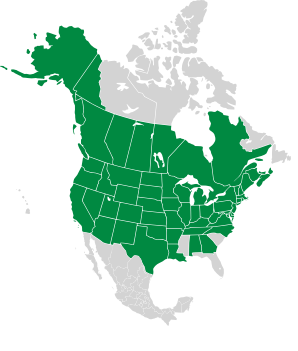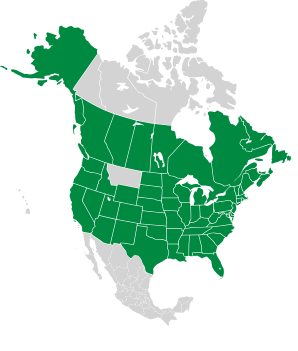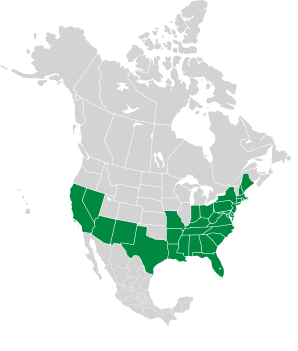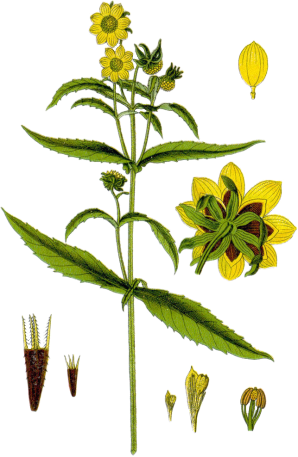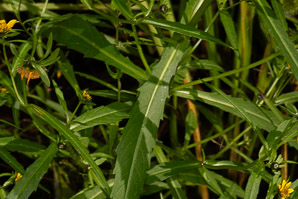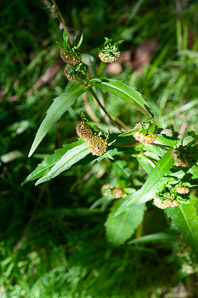|
Bidens cernua L.
Nodding beggartick, bur marigold, nodding bur marigold, sticktight
| Kingdom | Plantae | Plants, but not fungi, lichens, or algae |
| Subkingdom | Tracheobionta | Vascular plants—plants with a “circulatory system” for delivering water and nutrients |
| Division | Magnoliophyta | Flowering plants, also known as angiosperms |
| Class | Magnoliopsida | Dicotyledons—plants with two initial seed leaves |
| Subclass | Asteridae | A large class that encompasses asters |
| Order | Asterales | Flowering plants with a central disk flower and surrounding petals, like daisies |
| Family | Asteraceae | The aster family, which also includes daisies and sunflowers; from the Greek ἀστήρ, “star,” for the star-shaped flowers |
| Genus | Bidens | From Latin bis, “twice,” and dens, “tooth,” for the pair of bristles on the achenes |
| Species | cernua | “Nodding” or “hanging,” referring to the flowers |
About plant names...
Nodding beggar-ticks, so-called because their relatively large flowers tend to face sideways
or nod downwards, are found near shorelines and the edges of wetlands, in sandy or
mucky soil.
Plants: Plants can reach 13′ (4 m), but
are typically a few feet in height.
Leaves: Opposite, and sessile or
clasping—leaf bases wrap around the stem. Leaves
are 1½-8″ (4-20 cm) long × up to 1″ (2.5 cm) wide, and simple (unlobed).
Flowers: Composite flowers are
1-2″ (2.5-5 cm) across, and have up to
8 petals, though rarely the ray flowers are missing and only the tubular disk flowers
are present. The flowers are sideways-facing, rather than
upward-facing.
Fruits: Fruits are brown, hard, and triangular in shape,
with four barbed spears of roughly equal length called awns,
designed to hook onto anything that passes by.
These are similar:
|
|
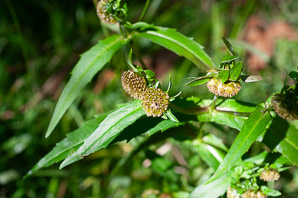
9/24/2012 · Squannacook River Wildlife Area, Townsend, Massachusetts · ≈ 9 × 6″ (22 × 14 cm) 
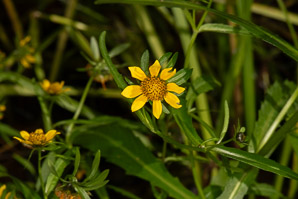
9/11/2021 · Otter Brook Preserve, Harpswell, Maine · ≈ 7 × 4½″ (17 × 11 cm) 
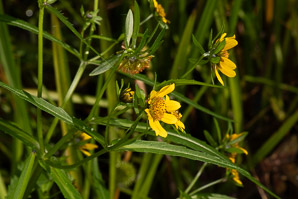
9/11/2021 · Otter Brook Preserve, Harpswell, Maine · ≈ 8 × 5″ (20 × 13 cm) 
|
| Plant |
Up to 13′ (4 m) high, usually less than 3′ (91 cm) |
1-3′ (30-91 cm) high, rarely up to 6′ (1.8 m). Stems are square in cross-section, nearly hairless, and light green, reddish green, or purple |
2-3′ (60-91 cm) high, rarely up to 6′ (1.8 m). Plants and flowers tend to look disheveled. |
| Flowers |
Composite flowers are 1-2″ (2.5-5 cm) across, have up to 8 petals, though rarely the ray flowers are missing and only the tubular disk flowers are present. The flowers are sideways-facing, rather than upward-facing |
Each composite flower is composed of 20-60 orange-yellow disc florets about ⅜-½″ (9.5-12 mm) around, and rarely a few yellow rays, each 1/16-⅛″ (2-3.5 mm) long. They are encompassed in 6-10 phyllaries, like a rosette of small leaves. Flowers occur in groups of 1-12, appearing from late summer to early fall. |
Yellow flowers are 1½-2½″ (3.8-6.3 cm) around, with 8 petals. Each is a composite flower. They bloom from July to October. |
| Leaves |
Opposite, and sessile or clasping—leaf bases wrap around the stem. Leaves are 1½-8″ (4-20 cm) long × up to 1″ (2.5 cm) wide, and simple (unlobed) |
Lower leaves are odd pinnate clusters on long petioles, in opposite pairs; upper leaves may be alternate. Leaves are up to 3″ (7.6 cm) × 1″ (2.5 cm), coarsely toothed, deltate or lanceolate. |
1½-8″ (3.8-20 cm) long, narrow, with coarse (dentate or serrate) teeth. They vary in shape from obovate or elliptic to lanceolate or linear |
| Fruit |
Fruits are brown, hard, and triangular in shape, with four barbed spears of roughly equal length called awns |
The seeds or achenes are shaped like a narrow triangle, with two barbed fork tips that attach to fur or clothes. The seeds are also distributed by the wind. |
Seeds have barbed tips, which hitchhike on passers-by to find new locations. |
| Habitats |
Near shorelines and the edges of wetlands, in sandy or
mucky soil |
Moist woods, meadows, thickets, fields, roadsides, railroads, borders of streams, ponds, sloughs, swamps, ditches |
Saturated or flooded soils |








